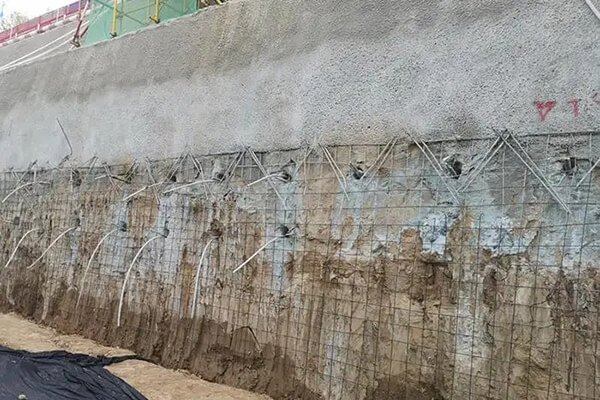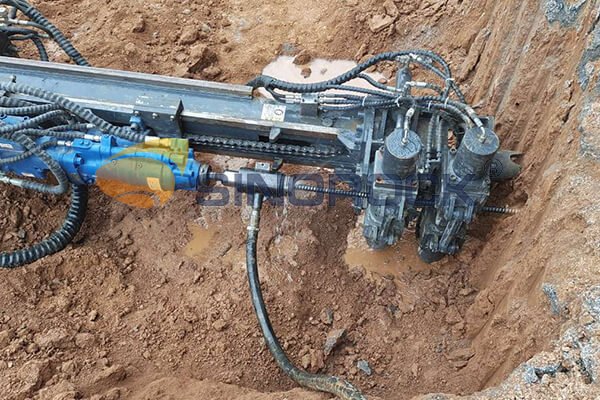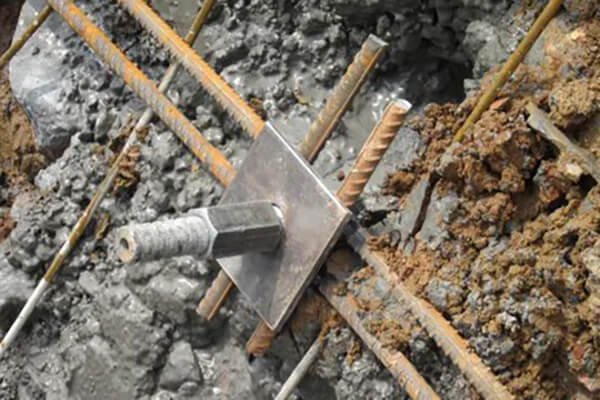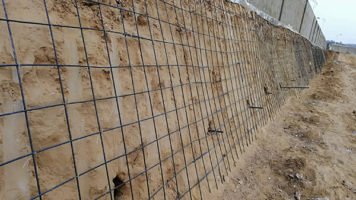In more and more engineering projects, especially in the effective support of foundation pits, slopes, and other structures prone to collapse and displacement, the soil nail retaining wall has gradually become a kind of supporting trend because it is stable, instant, and convenient.

So,
- What is a soil nail wall?
- What are the advantages of the soil nail retaining wall?
- How to construct a self-drilling soil nail retaining wall?
- What is the construction effect of self-drilling soil nail retaining walls?
Retaining Wall
Before understanding soil nailing walls, let’s first introduce what a retaining wall is.
The retaining wall uses its own integral mechanism to balance the lateral pressure of the slope soil and maintain the stability of the slope by the anti-sliding resistance and anti-overturning moment generated by its own weight. However, the retaining wall is an artificial masonry structure, which requires the excavation of the foundation pit to be in place at one time (and there is also a problem of slope stability during the excavation of the foundation itself), and the amount of excavation and backfilling is large, and the construction period is long, which is not economical.
Soil Nail Retaining Wall
Soil Nail Retaining Wall Definition
Soil nailing is an in-situ soil reinforcement technique. The slope of the foundation pit is reinforced by soil nails made of steel bars, a steel mesh is laid on the surface of the slope, and a layer of the concrete surface layer is sprayed with the combination of the earthwork slope and the slope reinforcement support construction method. The utility model is constructed as a composite body formed by firmly bonding a reinforced bar arranged in the slope body and its surrounding soil body, and a supporting structure similar to a gravity retaining wall formed by a surface layer.

The soil nail wall is composed of the reinforced soil body, the soil nail body wedged in the soil, and the concrete panel, similar to the gravity retaining wall, to resist the lateral pressure and external load from the back of the wall, and support the opening. Dig a slope, and the retaining wall is called a soil-nail wall. Drilling, reinforcing bars, and grouting are usually used, that is, the soil nails are formed by means of mortar anchors, or they can be directly driven to form soil nails. Generally, thicker angle steel or screw-spun steel bars are used. The shear strength is enhanced by reinforcing the soil by effectively wedging the soil nails, and the deformation of the soil between the soil nails is restrained by the formation of panels through the reinforced mesh shotcrete.
Advantages of Soil Nailing Walls
A. soil nail retaining wall significantly improves the overload capacity of the top of the slope and the overall stability of the slope;
B. The soil nail retaining wall is excavated and set in layers from top to bottom with the foundation pit. Once the excavation is completed, the soil nail wall will be built, which is particularly important for timely support of the slope composed of expansive soil;
C. It is not necessary to occupy the construction site alone, so this technology is especially suitable for the situation where the construction site is small, the slope is difficult to grade, and the construction machinery of large-scale slope protection cannot enter the site. The soil nail wall is only suitable for the miscellaneous fill, ordinary clay, and non-loose sand slopes above the groundwater level or after the drainage measures;
D. Fast construction speed: The soil nail wall is constructed with the earthwork excavation, layered and segmented, which can basically be synchronized with the earthwork excavation, and does not require maintenance or occupies the construction period alone. Therefore, in most cases, the construction speed is faster than other supporting structures;
How to Construct the Self-Drilling Soil Nail Wall?

Drilling
The main construction material of the self-drilling soil nail wall is the self-drilling hollow bolt. After the self-drilling hollow bolt is checked normally, connect the applicable drill bit to the bolt body, the drill bit is aligned with the designed drilling position, and the drilling rig should supply water first, and then drill. When drilling in broken rock formations, the water hole of the drill bit is easy to be blocked. Therefore, when drilling, the drilling speed should be slowed down, the rotation should be more, the impact should be less, and pay attention to the situation of water flowing out of the drilling hole. If the water hole is blocked, the anchor rod should be withdrawn about 50cm, and the hole should be swept repeatedly to make the water hole unblocked, and then slowly advance until the design depth.
Drill to the design depth, wash the hole with water or air, check whether the hole on the drill bit is unobstructed, and generally flush until the orifice returns water or air. Then connect the grouting machine to the tail end of the self-drilling hollow grouting bolt for grouting until the orifice returns to the grouting and stops grouting.
After the grout is solidified, a backing plate should be installed on the exposed part of the self-drilling hollow grouting bolt close to the surface of the rock mass, and then the backing plate should be fastened with nuts.
Hanging Net
Reinforcement mesh is processed, fabricated, and bound on site. When lashing on-site, first draw the line, then place the reinforcement, thread the reinforcement, tie it, and finally place the special spacer. When placing steel bars with welded joints and binding joints, the number of joints in the same section at the joint position, and the lap length shall be implemented in accordance with the current construction specifications. The intersections of the steel bars are made of iron wire. All stirrups are arranged vertically with the stressed steel bars, and the overlapping of the stirrup hooks is staggered along the direction of the stressed steel bars. In order to ensure the thickness of the protective layer, the thickness of the pad should be accurate and the strength should be guaranteed during prefabrication.
Shotcrete
After the soil layer is excavated and the slope surface layer is repaired, the total thickness of one-time spraying is 100mm in the weaving and welding of the steel mesh, and the concrete label is C20. Jet concrete should be mixed with the accelerator, the initial setting of concrete is less than 10min, and the final setting is less than 30min. The concrete ratio is: ordinary cement: sand and gravel 1:4-1:5 Sand ratio: 45-45% water-cement ratio: 0.4-0.45 Accelerator: 3-5% cement weight.
What Is the Construction Effect of Self-Drilling Soil Nail Walls?

Through the on-site non-destructive pull-out test, the pull-out force of a single soil nail exceeds the design value, the minimum is more than 6%, and the maximum is more than 6%.
57%. This shows that the application of soil nailing wall support technology in the slope support of the foundation pit of the building is successful. As long as the design is reasonable, the construction is strictly monitored, corresponding measures are taken according to the geological conditions of the specific site, and the construction management is in place, the supporting effect can be achieved.
Soil nail walls can be used not only for temporary structures but also selectively for permanent support. Such as underpinning the foundation, the support of the shaft, or the foundation pit, it can also replace the retaining wall on some slopes. To sum up, the soil nail wall is a technically reliable, fast construction, and economically feasible support scheme. Under the premise of the continuous progress of science and technology, it will be more widely used in various fields of engineering construction, and It has been continuously improved and improved in practice.



